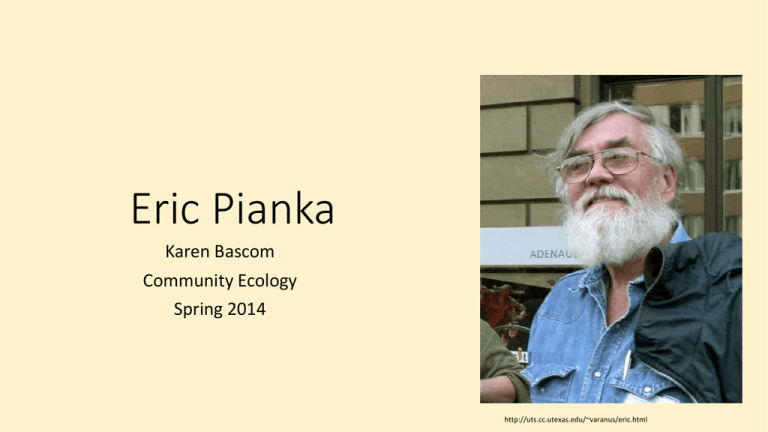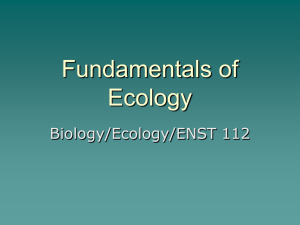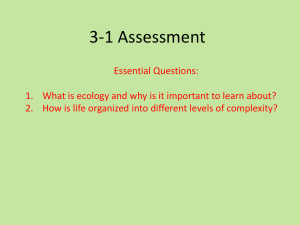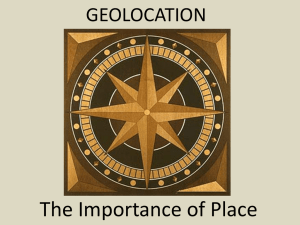
Eric Pianka
Karen Bascom
Community Ecology
Spring 2014
http://uts.cc.utexas.edu/~varanus/eric.html
Who is “The Lizard Man”?
• Current Position: Denton A. Cooley Centennial Professor of Zoology, University of
Texas-Austin
• Ecology of Desert Lizards
• Research Interests (from his department website):
“My interests are ever changing but have included population and community
ecology, evolutionary ecology, natural history of desert lizards, resource
partitioning, reproductive tactics, foraging theory, allocation, design constraints,
thermoregulation, rarity, metapopulations, historical accident and biogeography,
species diversity, macrodescriptors, pseudocommunities, phylogenetic systematics,
computer simulation of model systems, emergent properties of ecological systems,
indirect interactions among populations, disturbance, metapopulations, fire
ecology, succession, landscape ecology, and using phylogenies to reconstruct
probable ancestral states and deduce the course of evolution.”
Early Life
• Born 1939, Siskiyou Co.,
California
• Bazooka explosion injury
• (You thought EO Wilson
had a cool story)
http://uts.cc.utexas.edu/~varanus/bazooka.html
Education and Honors
• BA: Carleton College, 1960
• PhD: University of Washington, 1965
• Post-Doctoral Study: Princeton University
• Guggenheim Fellow, 1978
• Fellow, American Association for the Advancement of
Science, 1981
• Fulbright Senior Research Scholar, Australia, 1990
• D. Sc., (Ecology), University of Western Australia, 1990
• Fellow, Ecological Society of America, 2013.
Text-Wall of Publications
Pianka, E. R. and H. M. Smith. 1959. Distributional records for certain Mexican and Guatemalan reptiles. Herpetologica 15: 119-120.
Willson, M. F. and E. R. Pianka. 1963. Sexual selection, sex ratio, and mating system. American Naturalist 97: 405-407.
Pianka, E. R. 1966. Latitudinal gradients in species diversity: A review of concepts. American Naturalist 100: 33-46.
Pianka, E. R. 1966. Convexity, desert lizards, and spatial heterogeneity. Ecology 47: 1055-1059.
MacArthur, R. H. and E. R. Pianka. 1966. On optimal use of a patchy environment. American Naturalist 100: 603-609.
Pianka, E. R. 1967. On lizard species diversity: North American flatland deserts. Ecology 48: 333-351.
Pianka, E. R. 1968. Notes on the biology of Varanus eremius. Western Australian Naturalist 11: 39-44.
Pianka, E. R. 1969. Notes on the biology of Varanus caudolineatus and Varanus gilleni. Western Australian Naturalist 11: 76- 82.
Pianka, E. R. 1969. Habitat specificity, speciation, and species density in Australian desert lizards. Ecology 50: 498-502.
Pianka, E. R. 1969. Sympatry of desert lizards ( Ctenotus) in Western Australia. Ecology 50: 1012- 1030.
Pianka, E. R. and H. D. Pianka. 1970. The ecology of Moloch horridus (Lacertilia: Agamidae) in Western Australia. Copeia 1970: 90-103.
Pianka, E. R. 1970. Notes on Varanus brevicauda. Western Australian Naturalist 11: 113-116.
Pianka, E. R. 1970. Notes on the biology of Varanus gouldii flavirufus. Western Australian Naturalist 11: 141-144.
Pianka, H. D. and E. R. Pianka. 1970. Bird censuses from desert localities in Western Australia. Emu 70: 17-22.
Pianka, E. R. 1970. Comparative autecology of the lizard Cnemidophorus tigris in different parts of its geographic range. Ecology 51: 703-720.
Pianka, E. R. 1970. On r and K selection. American Naturalist 104: 592-597.
Pianka, E. R. 1971. Comparative ecology of two lizards. Copeia 1971: 129-138.
Pianka, E. R. 1971. Species diversity. Chapter in Topics in the Study of Life: The Bio Source Book, pp. 401-406. Harper and Row, New York.
Pianka, E. R. 1971. Notes on the biology of Varanus tristis. Western Australian Naturalist 11: 180-183.
Pianka, E. R. 1971. Ecology of the agamid lizard Amphibolurus isolepis in Western Australia. Copeia 1971: 527-536.
Pianka, E. R. 1971. Notes on the biology of Amphibolurus cristatus and Amphibolurus scutulatus. Western Australian Naturalist 12: 36-41.
Pianka, E. R. and R. B. Huey. 1971. Bird species density in the Kalahari and the Australian deserts.
Pianka, E. R. 1971. Lizard species density in the Kalahari desert. Ecology 52: 1024-1029.
Pianka, E. R. 1972. Zoogeography and speciation of Australian desert lizards: An ecological perspective. Copeia 1972: 127-145.
Pianka, E. R. and W. S. Parker . 1972. Ecology of the iguanid lizard Callisaurus draconoides. Copeia 1972: 493-508.
Pianka, E. R. 1972. r and K selection or b and d selection? American Naturalist 106: 581-588.
Parker, W. S. and E. R. Pianka. 1973. Notes on the ecology of the iguanid lizard, Sceloporus magister. Herpetologica 29: 143-152.
Pianka, E. R. 1973. The structure of lizard communities. Annual Review of Ecology and Systematics 4: 53-74
Parker, W. S. and E. R. Pianka. 1974. Further ecological observations on the western banded gecko, Coleonyx variegatus. Copeia 1974: 528-531.
Huey, R. B., E. R. Pianka, M. E. Egan, and L. W. Coons. 1974. Ecological shifts in sympatry: Kalahari fossorial lizards (Typhlosaurus). Ecology 55: 304-316.
Pianka, E. R. 1974. Niche overlap and diffuse competition. Proc. Nat. Acad Sci. 71: 2141-2145.
Huey, R. B. and E. R. Pianka. 1974. Ecological character displacement in a lizard. American Zoologist 14: 1127-1136.
Pianka, E. R. and W. S. Parker . 1975. Ecology of horned lizards : A review with special reference to Phrynosoma platyrhinos. Copeia 1975: 141-162.
Wake, D. B., R. G. Zwiefel, H. Desauer, G. Nace, E. R. Pianka, G. B. Rabb, R. Ruibal, J. Wright, and G. R. Zug. 1975. Report of the Committee on Resources in Herpetology. Copeia 1975: 391-404.
Wake, D. B., R. G. Zwiefel, H. Desauer, G. Nace, E. R. Pianka, G. B. Rabb, R. Ruibal, J. Wright, and G. R. Zug. 1975. Collections of preserved amphibians and reptiles in the United States. Herpetological Circ. 3: 1-22.
ake, D. B., R. G. Zwiefel, H. Desauer, G. Nace, E. R. Pianka, G. B. Rabb, R. Ruibal, J. Wright, and G. R. Zug. 1975. Recommendations for the management of herpetological museum collections. Herpetological Review 6: 34-36.
Pianka, E. R. 1975. Niche relations of desert lizards. Chapter 12 (pp. 292-314) in M. Cody and J. Diamond (eds.) Ecology and Evolution of Communities. Harvard University Press.
Pianka, E. R. and W. S. Parker . 1975. Age-specific reproductive tactics. American Naturalist 109: 453-464.
Parker, W. S. and E. R. Pianka. 1975. Comparative ecology of populations of the lizard Uta stansburiana. Copeia 1975: 615- 632.
Pianka, E. R. and H. D. Pianka. 1976. Comparative ecology of twelve species of nocturnal lizards (Gekkonidae) in the Western Australian desert. Copeia 1976: 125-142.
Parker, W. S. and E. R. Pianka. 1976. Ecological observations on the leopard lizard Crotaphytus wislizeni in different parts of its range. Herpetologica 32: 95-114.
Pianka, E. R. 1976. Competition and niche theory. Chapter 7 (pp. 114- 141) in R. M. May (ed.) Theoretical Ecology: Principles and Applications. Blackwell.
Pianka, E. R. 1976. Natural selection of optimal reproductive tactics. American Zoologist 16: 775-784.
Huey, R. B. and E. R. Pianka. 1977. Natural selection for juvenile lizards mimicking noxious beetles. Science 195: 201-203.
Pianka, E. R. 1977. Reptilian species diversity. Chapter 1 (pp. 1-34) in C. Gans and D.W. Tinkle (eds.) Biology of the Reptilia, Academic Press, New York.
Huey, R. B. and E. R. Pianka. 1977. Patterns of niche overlap among broadly sympatric versus narrowly sympatric Kalahari lizards (Scincidae: Mabuya). Ecology 58: 119-128.
Huey, R. B. and E. R. Pianka. 1977. Seasonal variation in thermoregulatory behavior and body temperature of diurnal Kalahari lizards. Ecology 58: 1066-1075.
Schall, J. J. and E. R. Pianka. 1977. Species densities of reptiles and amphibians on the Iberian peninsula. Donana, Acta Vertebrata 4: 27-34.
Pianka, E. R. and R. B. Huey. 1978. Comparative ecology, niche segregation, and resource utilization among gekkonid lizards in the southern Kalahari. Copeia 1978: 691- 701.
Schall, J. J. and E. R. Pianka. 1978. Geographical trends in numbers of species. Science 201: 679-686.
Schoener, T. W., R. B. Huey, and E. R. Pianka. 1979. A biogeographic extension of the compression hypothesis: Competitors in narrow sympatry. American Naturalist 113: 295-298.
Pianka, E. R. 1979. Diversity and niche structure in desert communities. Chapter 10 (pp. 321-341) in R. Perry and D.Goodall (eds.) Arid-Land Ecosystems: Structure, Function and Management, Cambridge University Press.
Pianka, E. R., R. B. Huey and L. R. Lawlor. 1979. Niche segregation in desert lizards. Chapter 4 (pp. 67-115) in D. J. Horn, R. Mitchell, and G. R. Stairs (eds.) Analysis of Ecological Systems. Ohio State University Press, Columbus.
Schall, J. J. and E. R. Pianka. 1980. Evolution of escape behavior diversity. American Naturalist 115: 551-566.
Pianka, E. R. 1980. Konkurrenz und Theorie der okologischen Nische. Chapter 7 (pp. 105-128) in R. M. May (ed.) Theoretische Okologie. Verlag Chemie, Basel.
Pianka, E. R. 1980. Guild structure in desert lizards. Oikos 35: 194- 201.
Huey, R. B. and E. R. Pianka. 1981. Ecological consequences of foraging mode. Ecology 62: 991-999.
Pianka, E. R. 1981. Competition and niche theory. Chapter 8 (pp. 167- 196) in R. M. May (ed.) Theoretical Ecology, Second Edition, Blackwell.
Pianka, E. R. 1981. Diversity and adaptive radiations of Australian desert lizards. Chapter 50 (pp. 1375-1392) in A. Keast (ed.) Ecological Biogeography in Australia. D. W. Junk, The Hague, Netherlands.
Pianka, E. R. and J. J. Schall. 1981. Species densities of terrestrial vertebrates in Australia. Chapter 59 (pp. 1675-1694) in A. Keast (ed.) Ecological Biogeography in Australia. D. W. Junk, The Hague, Netherlands.
Pianka, E. R. 1981. Resource acquisition and allocation among animals. Chapter 12 (pp. 300-314) in C. Townsend and P. Calow (eds.) Physiological Ecology: An Evolutionary Approach to Resource Use. Blackwell.
Ricklefs, R. E., D. Cochran, and E. R. Pianka. 1981. A morphological analysis of the structure of communities of lizards in desert habitats. Ecology 62: 1474-1483.
Pianka, E. R. 1982. Observations on the ecology of Varanus in the Great Victoria desert. Western Australian Naturalist 15: 37-44.
Pianka, E. R. and W. F. Giles. 1982. Notes on the biology of two species of nocturnal skinks, Egernia inornata and Egernia striata, in the Great Victoria desert. Western Australian Naturalist 15: 44-49.
Huey, R. B., E. R. Pianka, and T. W. Schoener. 1983. Introduction (pp. 1-6) in R. B. Huey, E. R. Pianka, and T. W. Schoener.(eds.) Lizard Ecology: Studies of a Model Organism. Harvard University Press.
Huey, R. B. and E. R. Pianka. 1983. Temporal separation of activity and interspecific dietary overlap (with an Appendix by S. L. Pimm). Chapter 13 (pp. 281-296) in Huey, R. B. , E. R. Pianka, and T. W. Schoener (eds.) Lizard Ecology: Studies of a
Model Organism. Harvard University Press.
Huey, R. B., E. R. Pianka, and C. M. Cavalier. 1983. Ecology of Lizards in the Kalahari Desert, Africa. National Geographic Society Research Reports 16: 365- 370.
Pianka, E. R. 1985. Ecological dynamics of Australian desert lizards: or, the L-area revisited. National Geographic Society Research Reports 18: 581-591.
Pianka, E. R. 1985. Some intercontinental comparisons of desert lizards. National Geographic Research 1: 490-504.
Pianka, E. R. 1985. A wild analogy. BioScience 35: 685.
Pianka, E. R. 1986. Ecological phenomena in evolutionary perspective. Chapter 16 (pp. 325-336) in N. Polunin (ed.) Ecosystem Theory and Application. Wiley and Sons.
Pianka, E. R. 1987. Waiting for the apple to fall, or pooling our brainpower. Bull. Ecol. Soc. America 68: 12-13.
Pianka, E. R. 1987. The subtlety, complexity and importance of population interactions when more than two species are involved. Revista Chilena de Historia Natural 60: 351-362.
Pianka, E. R. 1988. Destiny. Bull. Ecol. Soc. America 69: 33.
Pianka, E. R. 1989. Latitudinal gradients in species diversity. Trends in Ecology and Evolution 4: 223.
Pianka, E. R. 1989. Desert lizard diversity: additional comments and some data. American Naturalist 134: 344-364..
Pianka, E. R. 1989. The role of plants in evolutionary ecology. Evolutionary Trends in Plants 3: 75-80.
Winemiller, K. O. and E. R. Pianka. 1990. Organization in natural assemblages of desert lizards and tropical fishes. Ecological Monographs 60: 27-55.
Duellman, W. E. and E. R. Pianka. 1990. Biogeography of nocturnal insectivores: historical events and ecological filters. Annual Review of Ecology and Systematics 21: 57-68.
Pianka, E. R. 1991. Phrynosoma platyrhinos. Catalogue of American Amphibians and Reptiles. pp. 517.1-517.4.
Pianka, E. R. 1992. A land of lizards. Landscope 7 (3): 10-16.
Pianka, E. R. 1992. Fire Ecology. Disturbance, spatial heterogeneity, and biotic diversity: fire succession in arid Australia. Research and Exploration 8: 352-371.
Pianka, E. R. 1992. Evolution and the ecosystem. Pages 9-19 in S. Baba, O. Akerele, and Y. Kawaguchi (eds.) Natural Resources and Human Health - Plants of medicinal and nutritional value. Proceedings of the First World Health Organization
Symposium on Plants and Health for all: Scientific Advancement, Kobe, Japan, 26-28 August 1991. Elsevier Science Publishers.
Pianka, E. R. 1992. The state of the art in community ecology. In K. Adler (ed.) Herpetology. Current Research on the Biology of Amphibians and Reptiles. Proceedings of the First World Congress of Herpetology at Canterbury. Contributions to
Herpetology, Number 9: 141-162.
Pianka, E. R. 1992. Reproductive tactics. Pages 189-209 in R. Dallai (ed.) Sex origin and evolution. Proc. of International Symposium on Origin and Evolution of Sex, Siena, September 9-11, 1991. Mucchi Editore, Italy.
Pianka, E. R. 1993. The many dimensions of a lizard's ecological niche. Chapter 9 (pp. 121-154) in E. D. Valakos, W. Bohme, V. Perez-Mellado, and P. Maragou (eds.) Lacertids of the Mediterranean Basin. Hellenic Zoological Society. University of
Athens, Greece.
Haydon, D. T. , R. R. Radtkey, and E. R. Pianka. 1993. Experimental Biogeography: Interactions between stochastic, historical, and ecological processes in a model arch ipelago. Chapter 11 (pp. 117-130) in R. E. Ricklefs and D. Schluter (eds.) Species
Diversity in Ecological Communities: Historical and Geographical Perspectives. University of Chicago Press.
Heatwole, H. and E. R. Pianka. 1993. Natural History of the Squamata. Pages 197-209 in G. J. B. Ross (ed.) Fauna of Australia. Volume 2. Amphibia Reptilia Aves. Australian Biological and Environmental Survey, Canberra.
Vitt, L. J. and E. R. Pianka. 1994. Introduction and acknowledgments. Pages ix-xii in Vitt, L. J. and E. R. Pianka (eds.), Lizard Ecology: Historical and Experimental Perspectives. Princeton University Press. 403 pp.
Haydon, D. T., B. I. Crother, and E. R. Pianka. 1994. New directions in biogeography? Trends in Ecology and Evolution 9: 403-406.
Pianka, E. R. 1994. Comparative ecology of Varanus in the Great Victoria desert. Australian Journal of Ecology 19: 395-408.
Pianka, E. R. 1994. Biodiversity of Australian desert lizards. In C. I. Peng and C. H. Chou (eds.) Biodiversity and Terrestrial Ecosystems. Institute of Botany, Academica Sinica, Monograph Series No. 14, pp. 259-281.
Pianka, E. R. 1995. Evolution of body size: Varanid lizards as a model system. American Naturalist 146: 398-414.
Pianka, E. R. 1995. Desert lizard ecology: Panglobal comparisons. Hardun. Journal of the Israel Herpetological Information Center, No. 6: 25-38. (in hebrew).
Pianka, E. R. 1996. Long-term changes in lizard assemblages in the Great Victoria Desert: Dynamic habitat mosaics in response to wildfires. Chapter 8 (pp. 191-215) in M. L. Cody and J. A. Smallwood (eds.) Long-term Studies of Vertebrate
Communities. Academic Press.
Pianka, G. A., E. R. Pianka, and G. G. Thompson. 1996. Egg laying by thorny devils (Moloch horridus) under natural conditions in the Great Victoria desert. J. Roy. Soc. Western Australia 79: 195-198.
Perry, G. and E. R. Pianka. 1997. Animal foraging: past, present and future. Trends in Ecology and Evolution 12: 360-364.
Couper, P. J. and E. R. Pianka. 1997. Synonymy of Ctenotus monticola Storr, 1981 and Ctenotus hypatia Ingram and Czechura, 1990. Memoirs of the Queensland Museum 42: 12.
Pianka, E. R. 1997. Australia's thorny devil. Reptiles 5 (11): 14-23.
Pianka, E. R., D. M. Hillis, D. C. Cannatella, M. J. Ryan, and J. J. Wiens. 1998. Teaching Herpetology. Herpetologica 54 (Supplement): S3-S5.
Pianka, E. R. and W. L. Hodges . 1998. Horned lizards. Reptiles 6 (6): 48-63. Translated into Finnish in 2003, published as Sarvikonnaliskot -- Phrynosoma in Herpetomania 12: 5-19.
Pianka, G. A., E. R. Pianka, and G. G. Thompson. 1998. Natural history of thorny devils Moloch horridus (Lacertilia: Agamidae) in the Great Victoria desert. J. Royal Society of Western Australia 81: 183- 190.
Thompson, G. G., E. R. Pianka, and M. de Boer. 1999. Body temperatures of an arboreal monitor lizard, Varanus tristis (Squamata: Varanidae) during the breeding season. Amphibia- Reptilia 20: 82-88.
Thompson, G. G. and E. R. Pianka. 1999. Reproductive ecology of the black-headed goanna Varanus tristis (Squamata: Varanidae). Journal of the Royal Society of Western Australia 82: 27-31.
Thompson, G. G., M. de Boer, and E. R. Pianka. 1999. Activity areas and daily movements of an arboreal monitor lizard, Varanus tristis (Squamata: Varanidae) during the breeding season. Australian Journal of Ecology 24: 117-122.
Pearson, D. J., D. R. King, and E. R. Pianka. 1999. New localities for the western pygmy possum, Cercartetus concinnus. Western Australian Naturalist 22: 205-207.
Haydon, D. T. and E. R. Pianka. 1999. Metapopulation theory, landscape models, and species diversity. EcoScience 6: 316-328.
Haydon, D. T., J. K. Friar, and E. R. Pianka. 2000. Fire Driven Dynamic Habitat Mosaics in the Great Victoria Desert I: Fire Geometry. Landscape Ecology 15: 373-381.
Haydon, D. T., J. K. Friar, and E. R. Pianka. 2000. Fire Driven Dynamic Habitat Mosaics in the Great Victoria Desert II: A spatial and temporal landscape model. Landscape Ecology 15: 407-423.
Farlow, J. O. and E. R . Pianka. 2000. Body form and trackway pattern in Australian desert monitors (Squamata: Varanidae): Comparing zoological and ichnological diversity. Palaios 15: 235-247.
Huey, R. B., E. R. Pianka, and L. J. Vitt. 2001. How often do lizards "run on empty?" Ecology 82: 1-7.
Pianka, E. R. 2001. The wonderful lizards of Oz. Fauna 2: 8-17.
Thompson, G. G. and E. R. Pianka. 2001. Allometry of Clutch and Neonate Sizes in Monitor Lizards (Varanidae: Varanus). Copeia 2001: 443-458.
Winemiller, K. O., E. R. Pianka, L. J. Vitt, and A. Joern. 2001. Food web laws or niche theory? Six independent empirical tests. American Naturalist 158: 193- 199.
Pianka, E. R. 2001. The role of phylogenetics in evolutionary ecology. Pp. 1-20 in Herpetologia Candiana. P. Lymberakis, E. Valakos, P. Pafilis, and M. Mylonas (eds), Natural History Museum of Crete, So cietas Europaea Herpetologica, Irakleio Crete
2001.
Pianka, E. R. 2001. Evolutionary Stable Strategies. pp. 669-671 in Encyclopedia of Genetics, Academic Press.
Pianka, E. R. 2002. Species Diversity. In The Oxford Encyclopedia of Evolution.
Pianka, E. R. 2002. Adaptation. In a 4 volume Encyclopedia, titled "Biology for Students Vol. II. Evolution." Reference Division, Macmillan Publishing.
Pianka, E. R. 2002. Convergent Evolution. In a 4 volume Encyclopedia, titled "Biology for Students Vol. II. Evolution." Reference Division, Macmillan Publishing.
Pianka, E. R. 2002. Natural Selection. In a 4 volume Encyclopedia, titled "Biology for Students Vol. II. Evolution." Reference D ivision, Macmillan Publishing.
Pianka, E. R. 2002. Forward. Pages xi-xiii in J. B. Murphy, C. Ciofi, Colomba de La Panouse and T. Walsh (eds.) Komodo dragons: Biology and conservation. Smithsonian Institute Press.
King, D. R., E. R. Pianka, and B. Green. 2002. Biology, ecology, and evolution. Chapter 2 (pages 23-41) in J. B. Murphy, C. Ciofi, Colomba de La Panouse and T. Walsh (eds.) Komodo dragons: Biology and conservation. Smithsonian Institute Press.
Pianka, E. R. 2002. A general review of zoological trends during the 20th century. A. Legakis, S. Sfenthourakis, R. Polymeni, and M. Thessalou-Legaki, eds. Proc. 18th International Congress of Zoology, pp.3-13. Opening address at the 18th
International Congress of Zoology, Athens 2001.
Vitt, L. J., E. R. Pianka, W. E. Cooper, and K. Schwenk. 2003. History and the global ecology of squamate reptiles. American Naturalist 162: 44-60.
Pianka, E. R. 2003. Squamata. In Grzimek's Animal Life Encyclopedia. pp. 195-208.
Pianka, E. R. 2003. Agamidae. In Grzimek's Animal Life Encyclopedia. pp. 209-222.
Pianka, E. R. 2003. Dibamidae. In Grzimek's Animal Life Encyclopedia. pp. 271-272.
Pianka, E. R. 2003. Scincidae. In Grzimek's Animal Life Encyclopedia. pp. 327-338.
Pianka, E. R. 2003. Varanidae. In Grzimek's Animal Life Encyclopedia. pp. 359-368.
Thompson, G. G., P. C. Withers, E. R. Pianka, and S. A. Thompson. 2003. Assessing biodiversity with species accumulation curves: Inventories of small reptiles by pit-trapping in Western Australia. Austral Ecology 28: 361-383.
Thompson, G. G., S. A. Thompson, P. C. Withers and E. R. Pianka. 2003 Diversity and abundance of pit-trapped reptiles of arid and mesic habitats in Australia: Biodiversity for Environmental Impact Assessments. Pacific Conservation Biology 9: 120135.
Pianka, E. R. 2003. Australian Desert Varanids. Reptilia 30: 20-26. Translated in Europe into German and Spanish.
Pianka, E. R. and W. L. Hodges . 2003. Sarvikonnaliskot -- Phrynosoma. Herpetomania 12: 5-19.
Sweet, S. S. and E. R. Pianka. 2003. The lizard kings. Natural History 112(9): 40- 45.
Farlow, J. O. and E. R . Pianka. 2003. Body size overlap, habitat partitioning, and living-space requirements of terrestrial vertebrate predators: implications for large-theropod paleoecology. Historical Biology 16: 21-40.
Jennings, W. B., E. R. Pianka, and S. Donnellan. 2003. Systematics of the lizard family Pygopodidae with implications for the diversification of Australian temperate biotas. Systematic Biology 52: 757-780.
Vitt, L. J. and E. R. Pianka. 2003. Historical patterns in lizard ecology: what teiids can tell us about lacertids. In V. Perez -Mellado (ed.) Lacertids of the Mediterranean Basin. pp. 139-156.
Pianka, E. R. and D. R. King. 2004. Introduction. Chapter 1 (pp. 3-9) in Pianka, E. R. and D. R. King, eds. 2004. Varanoid Lizards of the World. Indiana University Press.
Molnar, R. E. and E. R. Pianka, E. R. 2004. Biogeography and Phylogeny of Varanoids. Chapter 3 (pp. 68-76) in Pianka, E. R. and D. R. King, eds. 2004. Varanoid Lizards of the World. Indiana University Press.
Jennings, W. B. and E. R. Pianka, E. R. 2004. Tempo and Timing of the Australian Varanus Radiation. Chapter 4 (pp. 77-87) in Pianka, E. R. and D. R. King, eds. 2004. Varanoid Lizards of the World. Indiana University Press.
Pianka, E. R. 2004. Varanus bengalensis. Pages 156-160 in Pianka, E. R. and D. R. King, eds. 2004. Varanoid Lizards of the World. Indiana University Press.
Pianka, E. R. 2004. Varanus olivaceus. Pages 220-224 in Pianka, E. R. and D. R. King, eds. 2004. Varanoid Lizards of the World. Indiana University Press.
Pianka, E. R. 2004. Varanus brevicauda. Pages 312-317 in Pianka, E. R. and D. R. King, eds. 2004. Varanoid Lizards of the World. Indiana University Press.
Pianka, E. R. 2004. Varanus eremius. Pages 328-334 in Pianka, E. R. and D. R. King, eds. 2004. Varanoid Lizards of the World. Indiana University Press.
Pianka, E. R. 2004. Varanus semiremex. Pages 462-465 in Pianka, E. R. and D. R. King, eds. 2004. Varanoid Lizards of the World. Indiana University Press.
Pianka, E. R. 2004. Varanus tristis. Pages 477-487 in Pianka, E. R. and D. R. King, eds. 2004. Varanoid Lizards of the World. Indiana University Press.
Pianka, E. R. 2004. Lanthanotus borneensis. Pages 535-538 in Pianka, E. R. and D. R. King, eds. 2004. Varanoid Lizards of the World. Indiana University Press.
Pianka, E. R. 2004. Evolution of Body Size and Reproductive Tactics. Chapter 9 (pp. 549-555) in Pianka, E. R. and D. R. King, eds. 2004. Varanoid Lizards of the World. Indiana University Press.
Pianka, E. R. and S. S. Sweet. 2005. Integrative biology of sticky feet in geckos. BioEssays 27: 647-652.
Vitt, L. J. and E. R. Pianka. 2005. Deep history impacts present day ecology and biodiversity. Proc. Nat. Acad Sci. 102:7877-7881.
Pianka, E. R. 2005. Zur Okologie und Naturgeschichte der Zwergbartagame (Pogona minor) in der Great Victoria Desert (Australien). Draco: 63-66.
Pianka, E. R. and H. S. Horn. 2005. Ecology's Legacy from Robert MacArthur. Chapter 11 (pp. 213-232) in K. Cuddington and B. Biesner, eds. "Ecological Paradigms Lost: Routes of Theory Change." Elsevier Academic Press.
Hibbitts, T. J., E. R. Pianka, R. B. Huey, and M. J. Whiting. 2005. Ecology of the Common Barking Gecko ( Ptenopus garrulus) in southern Africa. J. Herpetology 39: 509-515.
Vitt, L. J. and E. R. Pianka. 2006. The Scaly Ones. Natural History. 115 (6): 28-35.
Pianka, E. R. 2007. Molokki -- Piikikas paholainen. Herpetomania 16: 5-11 (in Finnish).
Huey, R. B. and E. R. Pianka. 2007. On Widely Foraging for Kalahari Lizards. Preface, pp. 1-10 in S. M. Reilly, L. D. McBrayer, and D. B. Miles, eds. "Lizard Ecology: The Evolutionary Consequences of Foraging Mode." Cambridge University Press.
Vitt, L. J. and E. R. Pianka. 2007. Feeding Ecology in the Natural World. Chapter 5, pp. 141-172 in S. M. Reilly, L. D. McBrayer, and D. B.Miles, eds. "Lizard Ecology: The Evolutionary Consequences of Foraging Mode." Cambridge University Press.
Huey, R. B. and E. R. Pianka. 2007. Lizard thermal biology: do genders differ? Amer. Natur.170: 473-478.
Sweet, S. S. and E. R. Pianka. 2007. Monitors, mammals and Wallace's Line. Third multidisciplinary world conference on monitor lizards, Alexander Koenig Museum, Bonn, Germany. Mertensiella 16: 79-99.
King, D. R. and E. R. Pianka. 2007. Ecology of the Pygmy Monitor Varanus brevicauda in Western Australia. Third multidisciplinary world conference on monitor lizards, Alexander Koenig Museum, Bonn, Germany. Mertensiella 16: 304-311.
Pianka, E. R. 2007. An update on the Ecology of the Pygmy Monitor Varanus eremius in Western Australia. Third multidisciplinary world conference on monitor lizards, Alexander Koenig Museum, Bonn, Germany. Mertensiella 16: 346-352.
Pianka, E. R. 2008. Autecology. In Jorgensen, S. E., ed. Encyclopedia of Ecology. Elsevier.
Pianka, E. R. 2008. Evolutionary Ecology. In Jorgensen, S. E., ed. Encyclopedia of Ecology. Elsevier.
Pianka, E. R. 2008. Optimal Foraging. In Jorgensen, S. E., ed. Encyclopedia of Ecology. Elsevier.
Pianka, E. R. 2008. r and K selection. In Jorgensen, S. E., ed. Encyclopedia of Ecology. Elsevier.
Pianka, E. R. 2008. Synecology. In Jorgensen, S. E., ed. Encyclopedia of Ecology. Elsevier.
Goodyear, S. E. and E. R Pianka. 2008. Sympatric Ecology of Five Species of Fossorial Snakes (Elapidae) in Western Australia. J. Herpetology 42: 279-285.
Costa, G. C., L. J. Vitt, E. R. Pianka, D. O. Mesquita and G. R. Colli. 2008. Optimal foraging constrains macroecological patterns: Body size and dietary niche breadth in lizards. Global Ecology and Biogeography 17: 670-677.
Harp, C. A., S. E. Goodyear, and E. R. Pianka. 2010. Ctenotus helenae (Helen's Comb-Eared Skink) Hermaphroditism. Herpetological Review 41: 353-354.
Pianka, E. R. 2010. Notes on the ecology of four species of pygopodid lizards in the Great Victoria Desert. Western Australian Naturalist 27: 175-181.
Pianka, E. R. 2011. Scientific Methods and Human Knowledge.
Pp. 1-7 in M. Hutchins, V. Geist, and E. R. Pianka, eds. Grzimek's Animal Life Encyclopedia, Evolution. Gale Publishing Group.
Pianka, E. R. 2011. Convergent evolution and ecological equivalence. Pp. 235-242 in M. Hutchins, V. Geist, and E. R. Pianka, eds. Grzimek's Animal Life Encyclopedia, Evolution. Ga le Publishing Group.
Pianka, E. R. 2011. Notes on the natural history of the tiny skink Menetia greyi. Western Australian Naturalist 28: 12-17.
Pianka, E. R. and C. A. Harp. 2011. Notes on the natural history of Buchanan's snake-eyed skink Cryptoblepharus buchananii in arid Western Australia. Western Australian Naturalist 28: 43-49.
Pianka, E. R. 2011. Notes on the ecology of some uncommon skinks in the Great Victoria Desert. Western Australian Naturalist 28: 50-60.
Goodyear, S. E. and E. R. Pianka. 2011. Spatial and temporal variation in diets of sympatric lizards (genus Ctenotus) in the Great Victoria Desert, Western Australia. J. Herpetology 45: 265-271.
Pianka, E. R. and S. E. Goodyear. 2012. Lizard responses to wildfire in arid interior Australia: Long-term experimental data and commonalities with other studies. Austral Ecology 37: 1-11.
Pianka, E. R. 2012. Can humans share spaceship earth? (“Point of View”) Amphibian and Reptile Conservation 6(1): 1-24(e49).
Böhm M. et al. (with coauthors including E. R. Pianka). 2013. The conservation status of the world’s reptiles. Biological Conservation 157: 372 -385.
Pianka, E. R. 2013. Notes on the ecology and natural history of two uncommon arboreal agamid lizards Diporiphora paraconvergens and Lophognathus
longirostris in the Great Victoria desert of Western Australia. Western Australian Naturalist 29: 77-84.
Pianka, E. R. 2013. Notes on the ecology and natural history of two uncommon terrestrial agamid lizards Ctenophorus clayi and C. fordi in the Great Victoria desert of Western Australia. Western Australian Naturalist 29: 85-93.
Pianka, E. R. 2013. Notes on the natural history of the rarely recorded agamid lizard Caimanops amphiboluroides in Western Australia. Western Australian Naturalist 29: 99-102.
Pianka, E. R. 2013. Notes on the ecology and natural history of the rarely recorded gekkonid lizard Heteronotia binoei in the Great Victoria desert of Western Australia. Western Australian Naturalist 29: 120-125.
Pianka, E. R. 2014. Rarity in Australian Desert Lizards. Austral Ecology 39, in press.
Books
http://uts.cc.utexas.edu/~varanus/books.html
Latitudinal Gradients in Species Diversity
• Published as a Graduate
Student!
• In review:
• Time
• Spatial Heterogeneity
• Competition
• Predation
• Climatic Stability
• Productivity
Pianka 1966a
On Optimal Use of a Patchy Environment
• Pianka’s First “Citation Classic”
• Economical choices in food selection
• Principle: Energy Gains>Energy Losses
• “Optimal Foraging Theory” (OFT)
http://en.wikipedia.org/wiki/Robert_MacArthur
Optimal Foraging Theory
• “Fine-Grained”
Environments
• Potential prey items
proportionally
distributed
MacArthur & Pianka 1966
Optimal Foraging Theory
• “Patchy” Environments
• Potential prey items
separated into discrete
areas
MacArthur & Pianka 1966
Optimal Foraging Theory
• Strategies differ between fine-grained and patchy environments
• Competition
• “Jack of all trades” will outcompete Specialist at low search
times
• Generalist will outcompete Jack at higher food densities
http://evhmecology2013.blogspot.com/2013_09_01_
archive.html
MacArthur & Pianka 1966
OFT In Desert Lizards
Cnemidophorus
“Jack-of-all-Trades”
Wide Foraging “Convex”
Phrynosoma
“Sit and Wait”
Specialist
Ants
Pianka 1966b
Influence of OFT
• >1750 Citations
• Inspired empirical testing of behavioral ecology
• “Convexity, Desert Lizards, and Spatial Heterogeneity” (Pianka 1966b)
• Anthropology and Human Evolution
• Criticism
• How does one measure the “Optimum”?
• “Do bumblebees forage optimally, and does it matter?” (Heinrich
1983)
• Newer adaptations incorporate other ecological factors
Perry & Pianka 1997
Niche Overlap and Diffuse Competition
Building on ideas from Elton, Hutchinson, MacArthur and May
Pianka 1974
Niche Overlap and Diffuse Competition
Niche Overlap
• Maximum overlap varies
inversely with
competition
• Does not imply
competition
• There may actually be
less!
Diffuse Competition
• Total effects of
interspecific competitors
• Strength of inhibition and
number of competitors
considered
Pianka 1974
Niche Overlap and Diffuse Competition
North America
http://uts.cc.utexas.edu/~varanus/herpetol.html
Africa
http://www.hardaker.co.za/challenge-reptiles.htm
Australia
http://uts.cc.utexas.edu/~varanus/herpetol.html
• Desert Lizard Diversity and Density
• Environmental Variation
• Trophic, Spatial, and Temporal Niche Dimensions
Pianka 1974
Niche Overlap and Diffuse Competition
Overlap between pairs decreases, but total overlap in the community increases
Pianka 1974
Niche Overlap and Diffuse Competition
• Provides empirical
support for niche overlap
hypothesis
• Diffuse effects contribute
to maximum overlap
more than environmental
variables and should be
considered in models
http://www.studyblue.com/notes/note/n/species-interactions-competition-chapt-11/deck/6283403
Pianka 1974
On r- and K- Selection
• Extension of MacArthur and
Wilson
• Bimodal distribution of
generation time
• Annual cycles are a possible
cause
• Body size
Pianka 1970
Influence of On r- and K-selection
• Perhaps too simplified?
• “Physics has friction less hockey
pucks, thermodynamics has
Carnot engines, and
evolutionary ecology has r- and
K-selection.” (Mueller 1997)
• Transition to age-specific
mortality
http://www.nature.com/scitable/knowledge/library/survivorship-curves-16349555
Reznick et al 2002
Recent Work
• Fire Cycles in Western
Australia
• Phylogenetics of Varanids
and Skinks
• Cataloging
http://uts.cc.utexas.edu/~varanus/eric.html
Effects of Fire Cycle on Lizards
Pianka & Goodyear 2012
He’s Not Dead, Yet!
Works Cited
• MacArthur, RH and ER Pianka. 1966. On optimal use of a patchy environment. The American Naturalist 100:603-609.
• Perry, G and ER Pianka. 1990. Animal foraging: past, present, and future. Trends in Ecology and Evolution 12:360-364.
• Pianka, ER. 1966. Latitudinal gradients in species diversity: A review of concepts. The American Naturalist 100:33-46.
• Pianka, ER. 1966. Convexity, desert lizards, and spatial heterogeneity. Ecology 47:1055-1059
• Pianka, ER. 1970. On r- and K-selection. The American Naturalist 104:592-597.
• Pianka, ER. 1973. The structure of lizard communities. Annual Review of Ecology and Systematics 4:3-74.
• Pianka, ER. 1974. Overlap and diffuse competition. Proceedings of the National Academy of Sciences of the United States of
America 71:2141-2145.
• Pianka, ER and SE Goodyear. 2012. Lizard responses to wildfire in arid interior Australia: Long-term experimental data and
commonalities with other studies. Austral Ecology 37:1-11.
• Reznik, D, MJ Bryant, and F Bashey. 2002. r- and K-selection revisited: The role of population regulation in life-history evolution.
Ecology, 83:1509-1520.
• University of Texas-Pianka Webpage. http://uts.cc.utexas.edu/~varanus/Index_to_ERP's_Web_Pages.html
Any Questions?
http://uts.cc.utexas.edu/~varanus/eric.html










